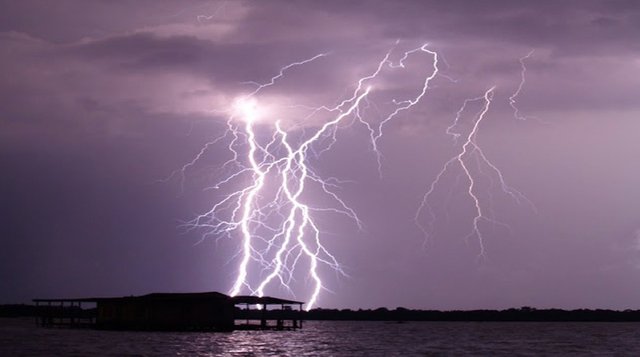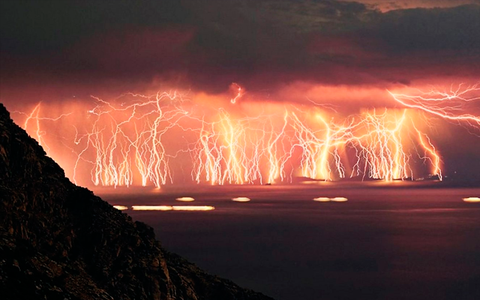Lightning of the Catatumbo, an ozone source (EN) - Relámpago del Catatumbo, una fuente de ozono (ES).

Image/Imagen: www.telesurtv.net
Lightning of the Catatumbo, an ozone source.
In Venezuela, Zulia State, south of Lake Maracaibo, Catatumbo municipality, we find one of the most fascinating phenomena of nature worldwide called "The lightning of Catatumbo". The southwest of Lake Maracaibo has the highest density of electric discharges (number of discharges per km2) of the entire planet, according to independent research from the University of Maryland and the Center for Scientific Modeling (CMC) of the University of Zulia.
"El Faro", as it is also known, since in ancient times, served as a reference to the boats that sailed in the lake, consisting of continuous thunderstorms with thunders that offer a beautiful light show, shining around 280 times by hour (up to 180 nights a year). They happen by groups located in different points; therefore it must be referred to "Lightnings."
The rays occur mainly within the clouds, or in the cloud-earth direction, which cause significant human losses and livestock in the area.
Its origin continues to represent an enigma; however there are several theories within which there is the confluence of currents of cold and hot air, the presence of uranium and methane.
The Catatumbo Lightnings are formed basically in the same way as any other lightning. They are unique because of the tropical location of the Lake Maracaibo basin and its proximity to the Caribbean Sea, the Lake itself as a regulator of humidity, temperature and breezes throughout the day and night, and especially the mountainous configuration that helps maintain the circulation of winds in the South of the Lake, are combined in a special way to produce this phenomenon.
The hypothesis of methane as the causal agent of the Lightning was suggested between 1998 and 2000 to try to understand what originated them but in the same way remains questioned.
In 2005 it was declared a natural heritage of the Zulia state and for several years it has been sought that UNESCO declares this a patrimony of humanity to become the first meteorological phenomenon to have this denomination.
In January 2010, the phenomenon disappeared for 8 months generating fear, and it was determined that this was due to the lack of climate control that has been registered, but recent studies revealed that it is still there and remains active.
It was included in the Guinness Book of 2016 On January 28, the Zulianity Day, in 2014 the document that endorsed the record by representatives of the organization was delivered to Zulia.
It has been determined that through the process of ionization, (transformation of an atom or a group of them into an ion through the capture or loss of electrons) that is generated during each electrical discharge; It has the capacity to repair the ozone layer, producing up to 10% of this element.
Ozone is produced by passing a silent electric discharge through gaseous oxygen. The reaction continues by the dissociation of an O2 molecule into O atoms and the combination of an O atom with a second O2 molecule:
However, it is very unlikely that the Catatumbo Lightnings will be the main regenerators of the planet's ozone layer since this gas is highly unstable and tends to transform itself into some other compound in a matter of hours. The time it takes for the ozone produced by the Catatumbo Lightnings to ascend to the ozone layer is at least 6 months, but there is no doubt that it has contributed greatly to its restoration and maintenance.
"El Faro" has inspired poets and artists to express their magnificence in their works, as it appears in our beautiful hymn composed by the poet Udón Pérez: "... La luz con que el relámpago, tenaz del Catatumbo, al nauta fija el rumbo cual límpido farol…”
It is worth visiting this beautiful, interesting and amazing place, of course, with the precaution of not being struck by a lightning!!
Image: The Lightning of Catatumbo in a high activity period.
(Source: https://www.latiendavenezolana.com)
Imagen: Los Relámpagos del Catatumbo en un momento de alta actividad.
(Fuente: https://www.latiendavenezolana.com)

El Relámpago del Catatumbo, una fuente de ozono.
En Venezuela, Estado Zulia, al sur del Lago de Maracaibo, municipio Catatumbo, encontramos uno de los fenómenos más fascinantes de la naturaleza a nivel mundial denominado “El relámpago del Catatumbo”, El Suroeste del Lago de Maracaibo posee la mayor densidad de descargas eléctricas (número de descargas por Km. cuadrado) del todo el planeta, según investigaciones independientes de la Universidad de Maryland y del Centro de Modelado Científico (CMC) de Universidad del Zulia.
“El Faro”, como también se le conoce, ya que en la antigüedad, servía como referencia a las embarcaciones que navegaban en el Lago, consiste en tormentas eléctricas continuas con truenos que ofrecen un hermoso espectáculo de luces, resplandeciendo alrededor de 280 veces por hora (hasta 180 noches al año). Ocurren por grupos localizados en distintos puntos, por lo tanto se debe referir a “Relámpagos del Catatumbo.”
Los rayos ocurren principalmente dentro de las nubes, o en sentido nube-tierra, los cuales causan importantes pérdidas humanas, de ganado y bienes materiales en la zona.
Su origen continúa representando un enigma, no obstante existen varias teorías dentro de las cuales figura la confluencia de corrientes de aires fríos y calientes, la presencia de uranio y metano.
Los Relámpagos del Catatumbo se forman básicamente de la misma manera que cualquier otro relámpago. Son únicos porque la ubicación tropical de la cuenca del Lago de Maracaibo y su cercanía al mar Caribe, el Lago mismo como regulador de humedad, temperatura y brisas a lo largo del día y la noche, y sobre todo la configuración montañosa que ayuda a mantener la circulación de vientos en el Sur del Lago, se conjugan de manera especial para producir este fenómeno.
La hipótesis del metano como agente causal de los Relámpagos fue sugerida entre 1998 y 2000 para tratar de entender qué los originaba pero de igual manera permanece cuestionada.
En el año 2005 fue declarado patrimonio natural del estado Zulia y desde hace varios años se busca que la UNESCO declare este fenómeno patrimonio de la humanidad para convertirse en el primer fenómeno meteorológico en tener esta denominación.
En enero del 2010 el fenómeno desapareció durante 8 meses generando temor, y se determinó que esto obedeció al descontrol climático que se ha registrado, pero estudios recientes revelaron que aún está allí y permanece activo.
Fue incluido en el Libro de Récord Guinness de 2016 El 28 de enero, el Día de la Zulianidad, de 2014 le fue entregado al Zulia el documento que avalaba el récord por representantes de la organización.
Se ha determinado que mediante el proceso de ionización, (transformación de un átomo o un grupo de ellos en un ión a través de la captación o pérdida de electrones) que se genera durante cada descarga eléctrica; posee la capacidad de reparar la capa de ozono, produciendo hasta un 10% de este elemento.
El ozono se produce pasando una descarga eléctrica silenciosa a través del oxígeno gaseoso. La reacción continúa mediante la disociación de una molécula de O2 en átomos de O y la combinación de un átomo de O con una segunda molécula de O2:
Sin embargo, es muy poco probable que los Relámpagos del Catatumbo sean los principales regeneradores de la capa de ozono del planeta ya que, este gas es altamente inestable y tiende a transformarse en algún otro compuesto en cuestión de horas. El tiempo que le toma al ozono producido por los Relámpagos del Catatumbo para ascender hasta la capa de ozono es de como mínimo 6 meses, pero no cabe duda que ha contribuido en gran parte a su restauración y mantenimiento.
“El Faro” ha inspirado a poetas y artistas plasmando su magnificencia en sus obras, tal como figura en nuestro hermoso himno compuesto por el poeta Udón Pérez: “…La luz con que el relámpago, tenaz del Catatumbo, al nauta fija el rumbo cual límpido farol…”
Vale la pena visitar este hermoso, interesante y alucinante lugar, claro está, con la precaución de no ser alcanzado por un rayo!!
References - Referencias:
- Estudio Multidisciplinario de los Relámpagos del Catatumbo, desarrollado por el Eje de Geociencias del CMC-LUZ. Investigador responsable: Ángel G. Muñoz.
-Los átomos, Salvat Editores, Barcelona.
This is what i told you about...be Original....
Posted using Partiko Android
Hi! sorry I was without pc. Barely I am come back! thanks for your comment!!
Amazing post loved ur post followed uh pivoted uh will be glad if u follow back and help us to grow in vast platform
Hi! thanks for comment!
Congratulations @soanna! You have completed the following achievement on the Steem blockchain and have been rewarded with new badge(s) :
Click on the badge to view your Board of Honor.
If you no longer want to receive notifications, reply to this comment with the word
STOPDo not miss the last post from @steemitboard: